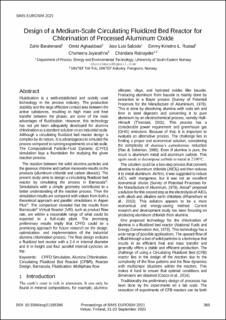| dc.contributor.author | Barahmand, Zahir | |
| dc.contributor.author | Aghaabbasi, Omid | |
| dc.contributor.author | Salcido, Jose Luis | |
| dc.contributor.author | Rustad, Emmy Kristine | |
| dc.contributor.author | Jayarathna, Chameera | |
| dc.contributor.author | Ratnayake, Chandana | |
| dc.date.accessioned | 2022-11-23T09:21:50Z | |
| dc.date.available | 2022-11-23T09:21:50Z | |
| dc.date.created | 2022-11-22T17:44:17Z | |
| dc.date.issued | 2022 | |
| dc.identifier.citation | Linköping Electronic Conference Proceedings. 2022, 185 . | en_US |
| dc.identifier.issn | 1650-3686 | |
| dc.identifier.uri | https://hdl.handle.net/11250/3033557 | |
| dc.description.abstract | Fluidization is a well-established and widely used technology in the process industry. The production stability and the large effective contact area between the active substances, resulting in high mass and heat transfer between the phases, are some of the main advantages of fluidization. However, this technology has not yet been adequately developed for alumina chlorination as a standard solution on an industrial scale. Although a circulating fluidized bed reactor design is complex by its nature, it is advantageous to simulate the process compared to running experiments on a lab scale. The Computational Particle-Fluid Dynamic (CPFD) simulation lays a foundation for studying the given reaction process. The reaction between the solid alumina particles and the gaseous chlorine and carbon monoxide results in the products (aluminum chloride and carbon dioxide). The present study aims to design a circulating fluidized bed reactor by simulating the process in Barracuda®. Simulations with a simple geometry contributed to a better understanding of the reaction process. Then the simulation results are compared with values from both a theoretical approach and parallel simulations in Aspen Plus®. The comparison revealed that the results from Barracuda® Virtual Reactor (VR), such as product flow rate, are within a reasonable range of what could be expected in a full-scale plant. The promising preliminary results imply that CPFD could be a promising approach for future research on the design, optimization, and implementation of the industrial alumina chlorination process. The final design includes a fluidized bed reactor with a 2.4 m internal diameter and 8 m height and four parallel internal cyclones on top. | en_US |
| dc.language.iso | eng | en_US |
| dc.publisher | Scandinavian Simulation Society | en_US |
| dc.rights | Navngivelse 4.0 Internasjonal | * |
| dc.rights.uri | http://creativecommons.org/licenses/by/4.0/deed.no | * |
| dc.subject | multiphase flow | en_US |
| dc.subject | fluidization | en_US |
| dc.subject | Barracuda | en_US |
| dc.subject | reactor design | en_US |
| dc.subject | Circulating Fluidized Bed Reactor (CFBR) | en_US |
| dc.subject | alumina chlorination | en_US |
| dc.subject | CPFD simulation | en_US |
| dc.title | Design of a Medium-Scale Circulating Fluidized Bed Reactor for Chlorination of Processed Aluminum Oxide | en_US |
| dc.title.alternative | Design of a Medium-Scale Circulating Fluidized Bed Reactor for Chlorination of Processed Aluminum Oxide | en_US |
| dc.type | Peer reviewed | en_US |
| dc.type | Journal article | en_US |
| dc.description.version | publishedVersion | en_US |
| dc.rights.holder | Copyright (c) 2022 Zahir Barahmand, Omid Aghaabbasi, Jose Luis Salcido, Emmy Kristine L. Rustad, Chameera Jayarathna, Chandana Ratnayake | en_US |
| dc.source.pagenumber | 8 | en_US |
| dc.source.volume | 185 | en_US |
| dc.source.journal | Linköping Electronic Conference Proceedings | en_US |
| dc.identifier.doi | 10.3384/ecp21185360 | |
| dc.identifier.cristin | 2078646 | |
| cristin.ispublished | true | |
| cristin.fulltext | original | |
| cristin.qualitycode | 1 | |

